Vol 4 No. 46 TROPIC LIGHTNING NEWS November 17, 1969
Index
If You Were Vietnamese, Would You Like Us?
A Command Message From General Hollis
Every day we have dealings with Vietnamese citizens. The
truck driver in the convoy about to pass through a small, busy village; the
rifleman walking by a farmer's home and rice field; the MP on the base camp
main gate; the NCO waiting to make a purchase at the PX; the soldier confronting
local children in a fire support base trash dump; those Americans in their
ordinary actions toward the Vietnamese people have a profound effect upon what
we have tried so very hard, and at such terrible cost, to accomplish in this
land.
Today, if a young American is shot by the enemy and dies, and a few
miles away another soldier in a jeep speeds dangerously through a hamlet, shouts
"Gook" at a pedestrian and gestures rudely at schoolgirls, what is the
result? The first soldier clearly did not die in vain. But did not
the second soldier set our efforts back in a very real sense? We must
realize that simple human courtesy is a mighty and valuable weapon against the
Communist effort in Vietnam.
One element of our daily mission here is to convince that element
of the population which is still uncommitted to the concept of liberty that
freedom of choice is better than life under the Communists. To an ordinary
Vietnamese citizen this must be demonstrated by these who come to Vietnam in the cause of freedom. How he will
be treated by the next American he meets will surely guide him in choosing.
If that American is highhanded and boorish, unthinking and insensitive, crude or
just careless, the Vietnamese will get a message he will long remember; a
message which will cloud the accomplishments that the soldiers of the Tropic
Lightning Division have made by valor on the battlefield.
We owe it to our comrades fallen in battle, we owe it to all
Americans and free people everywhere, we owe it to our talented and gracious
Vietnamese friends - above all we owe it to ourselves - to improve our performance
in this regard.
HARRIS W. HOLLIS
Major General, USA
Commanding
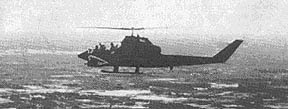 |
|
25th Aviation Bn Named Best in Army - Pages 4, 5 |
All Roads Lead NVA to Warrior
Ambushes: 26 Enemy Meet End
By PFC JIM WILLIAMS
CU CHI - A three-company Warrior ambush north of Fire Support Base
Pershing recently netted 26 enemy killed and led to discovery of a large cache
of enemy weapons and equipment.
The action also resulted in destruction of a much-used
R&R center for enemy troops based in the Boi Loi and Ho Bo Woods.
THE OPERATION began with the 6:30 pm airlifting of the Warriors'
Alfa and Charlie Companies to a 3d Squadron, 4th Cavalry night laager site
located along Highway 6-A north of Pershing.
As darkness fell the two Warrior companies prepared to move to
ambush positions north and west of the suspected location of an enemy encampment
in a nearby village.
Meanwhile, Bravo Company left Pershing to set up ambushes east and
south of the targeted area.
WITH COMPANIES A and C in position, Bravo approached the village.
Specialist 4 Charles La Place of Deer Isle, Maine, recalled: "We spotted
several enemy and got down, but they saw us and opened up. We returned
fire and soon bullets were flying everywhere."
Enemy soldiers, realizing that their R&R had come to an abrupt
end, started high-tailing it out of the hootches when the shooting started and
headed for the safety of open fields. However, they were met there by
Alpha, then Charlie Company Warriors.
"Alfa blew their ambush and the NVA did an about face and headed
our way," said Specialist 4 Edward Vaughn of Pittsburgh.
THE BEWILDERED enemy soldiers were running everywhere. While
this was taking place, gunships began backing up the infantrymen as the light of
parachute flares illuminated the scene.
At one point, according to weapons squad leader Sergeant Harold
Fullam of Thomasville, N.C., "The enemy wasn't more than 50 meters from the
ambush locations. They were moving along as if they were on a Sunday
picnic, except that they were all loaded down with weapons and equipment."
At the first light of dawn, the Warriors began a series of several
sweeps covering the entire village area.
SERGEANT GARY Ricci of Staten Island, N.Y., described the scene:
"We were walking a dike and a Vietnamese jumped up yelling, 'Chieu Hoi!
Chieu Hoi!' His pants kept falling down, and he was trying to keep them up and
hold his hands high at the same time. I was sure lucky he didn't have a
weapon; he could have done me a job."
A sweep of the area after the action resulted in a tally of 26
enemy killed, two detainees, six AK-47 rifles, two K-54 pistols and an
assortment of equipment and clothing.
Specialist 4 Curtis Edgar, commenting on the overall operation,
said: "We sure knew exactly what we were doing last night. I've never
seen anything run so smoothly in the entire nine months I've been here."
|
Cav Catches Cash Cache By 1LT J. T. RICHARDS CU CHI - Enemy finances suffered a huge loss at the hands of the men of Alfa Troop, 3d Squadron, 4th Cavalry recently. Raiders of the 3d Platoon followed Charlie into his hideaway in the Mushroom area near Patrol Base Hunsley and found 2,125,000 piasters stashed in the NVA piggy bank. That's a little less than $20,000 in real money. "WE FOUND a breathing hole in a clump of suspicious-looking bushes," Sergeant Lonnie Dotson of Tacoma, Wash., said. "We started poking around and pretty soon we found a large bunker and tunnel." There were three NVA inside. They were given a chance to Chieu Hoi, and one of them came out of a hole a short distance away. Two others remained in the bunker, but smoke grenades soon forced them out. "We heard a lot of coughing and choking, and when it stopped we went in and found the two NVA dead," Dotson said. PRIVATE FIRST Class Alvin Hite of New Orleans, Private First Class Hal Lehman of Cape Girardeau, Mo. and Specialist 4 Marlow Kapuli of Honolulu searched the bunker and tunnel. "We just started passing bags of things out," Hite said. "It wasn't until we got out of there and started going through everything that we found all the money. It was bundled and wrapped in plastic and packed in old ammo cans. When I saw how much there was I thought, 'Wow! We're all rich.'" It was discovered later that the three NVA were all high-ranking officers in a rear service group. THEY WERE IN charge of purchasing food supplies. Documents found with the money indicated the enemy supply officers intended to buy 500,000 liters (or approximately 10,000 hundred pound bags) of rice for the month of November. Thanks to the men of Alfa Troop, the money will not be used to buy food for the enemy. Instead, it will be used to support a wide variety of pacification programs, including the possibility of building a new school. |
Golden Dragons Make Certain
There's No Rest for the
Wicked
BY PFC GREG STANMAR
CU CHI - Activity with the 2d Battalion, 14th Infantry area of
operations hasn't given anyone, especially the enemy, time to take it easy.
All four Golden Dragon maneuver companies, helicopter gunships and
two Tropic Lightning mechanized companies combined forces to down 30 enemy and
capture eight more during one six-day period recently.
THE BIGGEST single action occurred when the Dragon Recon Platoon
spotted a large group of enemy while on a night ambush patrol. The enemy
did not expect the American unit to be in the area, and they were taken
completely by surprise.
The Dragons held off until the NVA force was within their gunsights.
Then they opened up, killing six of the enemy.
On a sweep the next day the GIs found three more enemy taking
refuge in a tunnel complex. All three of them were persuaded to surrender.
Charlie Company, meanwhile, observed seven enemy, also while on an
ambush patrol. However, the NVA soldiers were too far away for small arms
fire to be effective. Well-placed 81mm mortar fire was called in,
resulting in four enemy killed.
FOLLOWING THE example of the Recon Platoon, Charlie Company teamed
up with troopers of the 3d Squadron, 4th Cavalry to take three detainees on a
sweep the following morning. In addition to the detainees, 60 pounds of
rice and a large quantity of medical supplies were rounded up.
Alfa Company, working with the 1st Battalion (Mechanized), 5th
Infantry near the Cambodian border, killed five NVA while on a night operation.
The Dragons' Bravo and Delta Companies added one more NVA killed
and a number of bunkers destroyed to the battalion total while sweeping through
the Ho Bo Woods and the Filhol Plantation.
And gunships working with the Golden Dragons during the period
accounted for another 14 enemy killed.
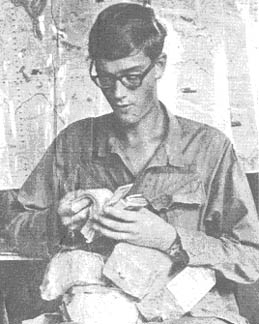 |
HOW MUCH IS IT IN DOLLARS? - Specialist 4 Doug Marxhausen checks a part of a cache of piasters worth $20,000 found by some of his buddies from the 3d Squadron, 4th Cavalry. (Photo by 1Lt J. T. Richards) |
Page 2 TROPIC LIGHTNING NEWS November 17, 1969
Decorated
| SILVER STAR | |
|
CPT William A. Branch, Co A, 2d Bn, 14th Inf CPT Thomas H. Grace, Co A, 2d Bn, 34th Armor SPC Dennis F. Johnson, Co A, 2d Bn, 12th Inf SSG David Fanesi, Co A, 2d Bn, 12th Inf SSG Carl M. Hutchens, D Trp, 3d Sqdn, 4th Cav SSG Stewart P. Ledwith, D Trp, 3d Sqdn, 4th Cav SSG Sylvester Shigg, D Trp, 3d Sqdn, 4th Cav SP5 Roger L. Blanchfield, Co C, 2d Bn, 14th Inf |
SP4 James P. Byrd, Co A, 2d Bn, 12th Inf SP4 Dr ald Graham, Co A, 2d Bn, 12th Inf SP4 William Gubser, Co A, 2d Bn, 12th Inf SP4 Jay D. Hicks, Co A, 2d Bn, 12th Inf PFC William O. Gifford, Co A, 2d _Bn, 12th Inf PFC Robert Henger, Co A, 2d Bn, 12th Inf PFC William Osborne, Co A, 2d Bn, 12th Inf |
| DISTINGUISHED FLYING CROSS |
|
|
CPT William V. Chiaramonte, D Trp, 3d Sqdn, 4th Cav CPT Richard Goldsmith, Co S, 2d Bn, 22d Inf CPT Robert P. Mack, D Trp, 3d Sqdn, 4th Cav CPT Thomas J. Sinclair, D Trp, 3d Sqdn, 4th Cav |
1LT John Thomas Jr., D Trp, 3d Sqdn, 4th Cav CW2 Thomas S. Benkelman, D Trp, 3d Sqdn, 4th Cav WO1 James D. Tonnelli, D Trp, 3d Sqdn, 4th Cav SP5 Charles D. Vieira, D Trp, 3d Sqdn, 4th Cav |
| SOLDIER'S MEDAL |
|
| SFC Dale L. Parsons, HHC, 65th Engr Bn. | SGT David R. Lee, HHC, 65th Engr Bn |
BRONZE STAR FOR HEROISM |
|
|
LTC James E. Coggins, HHC, 4th Bn, 23d Inf MAJ Igor D. Gerhardt, HHC, 4th Bn, 23d Inf CPT John J. Menning, HHB, 1st Bn, 8th Arty CPT Jose Martinez, Co B, 2d Bn, 14th Inf 1LT Timothy P. Jackowski, HHSB, 1st Bn, 8th Arty 1LT John E. Markham, Co C, 3d Bn, 13th Arty 1LT Edward H. Menges, Co B, 2d Bn, 14th Inf 1LT John A. Seaquist, Co F, 75th Inf 1LT Robert M. Sees, Co C, 2d Bn, 22d Inf 1LT Robert J. Simpson, Co E, 2d Bn, 12th Inf 2LT Larry M. Duhravetz, Co C, 4th Bn, 23d Inf 2LT Kenneth V. Frey, Co A, 4th Bn, 9th Inf 2LT John R. Pirack, Co B, 2d Bn, 22d Inf 2LT Matthew E. Vierra, Co A, 1st Bn, 5th Inf 1SG Oliver W. Anglin, Co A, 65th Engr Bn SFC Willie M. White, Co D, 4th Bn, 23d Inf |
SSG James A. Rogers, Co D. 2d Bn, 12th Inf SSG Woodrow H. Smith, Co A, 4th Bn, 9th Inf SGT Thomas Belew, Btry B, 7th Bn, 11th Arty SGT David Blaney, Co 9, 2d Bn, 12th Inf SGT John F. Dumschat, Co B, 2d Bn, 27th Inf SGT Victor M. Espinosa, Co B, 2d Bn, 27th Inf SGT Lynn A. Miller, Co C, 4th Bn, 23d Inf SGT James R. Sallee, Co A, 2d Bn, 12th Inf SGT Dennis S. Sanderson, Co A, 2d Bn, 14th Inf SGT Robert Sprongman, Co A, 4th Bn, 9th Inf SGT Alfred A. Verandi, Co A, 4th Bn, 23d Inf SGT Earl Waldrip, Co C, 2d Bn, 14th Inf SP4 Raymond Alcantra, Co A, 2d Bn, 12th Inf SP4 Dean W. Bridenbarker, Co B, 2d Bn, 27th Inf SP4 Robert A. Bouton, Co B, 2d Bn, 22d Inf |
Don't Delay Your DEROS:
Know Customs Limitations
You say you've got twenty minutes until DEROS and you're still
wondering how you're going to fit that howitzer in your duffle bag? Is
that what's troubling you, bunky?
Herewith, the Tropic Lightning News presents another quiz, designed
to test your knowledge of customs laws and what you can and can't take home
with you. A score of 100 percent qualifies you for (a) an undelayed DEROS;
(b) two smiles from the stewardess instead of one; and (c) a duffle bag
capable of being lifted by only one individual. The quiz is based on
information taken from a USARV fact sheet entitled "Custom Laws and You."
(1) As a U.S. Government employee, you are entitled to free entry
back into the world provided you have legitimate PCS, TDY or ETS orders.
This duty exemption applies only to those articles which include: (a) no
more than 15 (fifteen) autographed pinups of Raquel Welch; (b) household
and personal effects, automobiles and certain bona fide gifts; (c) your
Vietnamese hootch maid.
(2) What items are you prohibited from taking or sending home?
(a) US Government property, narcotics, certain weapons, merchandise manufactured
in Communist China, North Vietnam or North Korea, and obscene or seditious
literature; (b) more than two bottles of nuoc mam sauce; (c) the
South Vietnamese national debt.
(3) Items purchased in the exchange system can be shipped home
duty-free provided they cost under $50 and (a) weigh less than Kate Smith;
(b) don't yell "boo!" at the Vietnamese customs officials; (c)
qualify as bona fide gifts and are clearly marked "Bona fide gift-$50
exemption claimed under PL 89-368" on the package's outer wrapper.
(4) War trophies (enemy material acquired in a combat zone) may not
be mailed or shipped to the United States, but the Army does allow you to (a)
carry them home with you on the plane provided you have your commander's
authorization and your provost marshal has given you an export license;
(b) yell 'chieu hoi" as you carry the weapon onto your freedom bird;
(c) hijack a water buffalo to Nui Ba Den.
The answers: 1(b); 2-(a); 3-(c); 4-(a).
TROPIC LIGHTNING
Combat Honor Roll
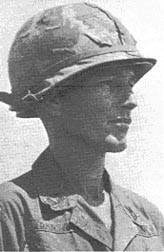 Platoon Sergeant Dennis Johnson of Alfa Company, 2d Battalion, 12th
Infantry has been added to the Tropic Lightning Combat Honor Roll.
Platoon Sergeant Dennis Johnson of Alfa Company, 2d Battalion, 12th
Infantry has been added to the Tropic Lightning Combat Honor Roll.
In early October, Johnson was on a search operation with the lead
element of Alfa Company when the Warrior unit discovered several enemy soldiers
hiding in a hut.
The enemy troops immediately fled the area and ran into an area of
thick vegetation nearby. Johnson quickly organized a search team and led
it through the enemy's suspected hiding place.
By using a probe Johnson discovered a well-concealed enemy bunker.
Knowing his position had been located, the enemy emerged from the bunker
throwing grenades and firing AK-47 rifles.
Johnson maneuvered and began to engage the enemy with only a
pistol, exposing himself to the enemy's fire. One of the enemy was
killed. Because of his accurate fire, Johnson forced the other enemy
soldiers to run directly into the rear security forces.
The enemy force was completely routed by the Alfa Warriors, due in
large part to Johnson's aggressiveness and courage.
Tropic Lightning Tots
The Commanding General Welcomes
The Following Tropic Lightning Tots
To The 25th Infantry Division – As
Reported By The American Red Cross.
Born To:
| August 7 PFC Dennis Brown, HHC 2/14 Inf, girl October 29 SP4 Richard Colombo, HHB DIVARTY, boy SGT Ronald Hudnall, B Trp 3/4 Cav, girl October 30 SGT Joe B. West, 25 Admin Co, boy SP4 Paul Szachitowski, B 25th Med Bn, girl SP4 George P. Bass, D 2/12 Inf, boy |
October 30 PFC William H. Griffin, B 1/5 Inf, boy October 31 PFC Fred T. Lester, A 25 Avn Bn, girl November 1 SP4 Tommy G. Simmons, A 25 Avn Bn November 3 PFC Clarence E. Burrows, C 65 Eng Bn, girl |
The TROPIC LIGHTNING NEWS is an authorized publication of the 25th Infantry Division. It is published weekly for all division units in the Republic of Vietnam by the Information Office, 25th Infantry Division, APO San Francisco 96225. Army News Features, Army Photo Features, Armed Forces Press Service and Armed Forces News Bureau material are used. Views and opinions expressed are not necessarily those of the Department of the Army. Printed in Tokyo, Japan, by Pacific Stars and Stripes.
MG Harris W. Hollis . . . . . . . Commanding General
MAJ Warren J. Field . . . . . . Information Officer
1LT John C. Burns . . . . . . . . Officer-in-Charge
SP4 Ralph Novak . . . . . . . . . Editor
SP4 Harold O. Anderson . . Assistant Editor
SGT John Genitti . . . . . . . . . Production Supervisor
BATTALION CORRESPONDENTS
| SP4 Dennis Bries SP4 Bill Frame SGT Bill Obelholzer SGT Larry Goodson PFC Jim Williams SGT Wally Baker SP4 Frank Ditto PFC Greg Stanmar SP4 Phil Jackson SP4 Pat Morrison SP5 Tony DeBlasio PFC Rich Fitzpatrick |
2/22 4/23 4/23 2/12 2/12 2/34 2/14 2/14 2/27 3/13 2/12 1/5 |
PFC Doug
Sainsbury SP4 Ken Barron SP4 Tony Crawford SP5 Pete Freeman SP4 Craig Sampson SP4 Richard Sears SGT K.C. Cullen Henry Zucowski SP4 Brad Yaeger PFC Frank Rezzonico SP4 Ken Fairman |
2/77 1/8 4/9 7/11 2/27 4/9 3/22 2/22 1/27 1/27 DIVARTY |
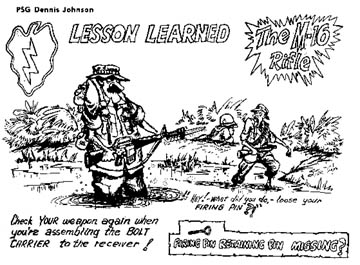 |
Page 3 TROPIC LIGHTNING NEWS November 17, 1969
Intelligence Section Zeroes in
3d Bde Targeting Hits Bullseye
By SSG JACK R. ANDERSON.
CU CHI - Targeting doesn't sound like a subject an intelligence
section should be interested in, but Tropic Lightning's 3d Brigade S-2 is
interested and the results are just as devastating as an artillery barrage.
Targeting, a term used by civil affairs and intelligence personnel,
means using maximum effort to discover everything there is to know about enemy
units working in a particular area, and then to systematically destroy that
unit.
"USUALLY, destruction isn't accomplished by force of arms,"
said a 3d Brigade intelligence officer. "We try to make it so hard for
the enemy to operate that he has one of two choices. Either he can remain
a guerrilla and starve or rally to the government of Vietnam and live."
A good example of the effectiveness of targeting was displayed last
month when the last member of the Hau Nghia City Company rallied to the
government. That company is now defunct.
The newest target for the 3d Brigade pacification program is the
Duc Hoa Local Force Company.
"IN THE LAST three months, we've reduced what was almost a
battalion-sized element to a squad," a spokesman said. "One whole unit
picked up its gear and left the area, probably heading for Cambodia.
We're slowly whittling away at the small unit that's still in the area."
One of the most important aspects of targeting is discovering and
eliminating enemy supply channels.
"We learn which villages they frequent and then set up security
in them," the spokesman said. "The Viet Cong don't dare come into
these places and they can't go to other secure villages because the people
won't have anything to do with them."
"The enemy has a tough choice to make. He can stay with his
unit and eventually die, maybe be taken prisoner, or he can Chieu Hoi. We
hope he Chieu Hois," the spokesman said.
TARGETING ALSO hits the family angle. Intelligence agents
learn the whereabouts of guerrillas' families and have their houses staked
out.
"When the VC realizes he won't be able to see his family
without risk of death, he is more apt to turn himself over to Vietnamese
authorities," the official said.
In one instance, the wife of a key VC insisted he rally and seek
medical aid.
"The man was very sick and couldn't get treatment elsewhere and
the wife wasn't willing to lose him because of it. Now, he's giving us
much valuable information and that's the object of the whole program."
| EFFORT REWARDED - Major General Nguyen Xuan Thinh, commander of the 25th ARVN Division, awards the Vietnamese Cross of Gallantry to 3d Squadron, 4th Cavalry Commander Lieutenant Colonel Joseph R. Paluh and his men in ceremonies at Cu Chi. It was the first time an American Army battalion-sized unit had ever received the award, which was given for the Cav's work since September 1966. The citation said the Tropic Lightning unit "has participated in almost all of the important operations conducted in the III Corps Tactical Zone and has inflicted heavy losses on the enemy." Crediting the Cav with killing 540 enemy soldiers, the citation added that despite "unfavorable terrain and heavy enemy fire, the men of the 3d Squadron, 4th Cavalry fought bravely, using lightning tactics to destroy and neutralize many Viet Cong and North Vietnamese main force unit's." (Photo by Sgt Tony Camelio) | 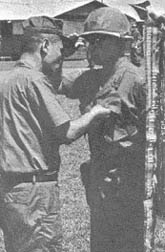 |
Round-about Route Speeds 3d Brigade Re-supply Runs
CU CHI - A resupply system designed to get maximum use of Chinook
helicopter blade time is delivering hot chow to the men at 3d Brigade outposts
four times faster than they used to get it.
It's called the merry-go-round.
Ammunition, water and all of the other necessities of combat life
are being delivered in record time, too.
THE SYSTEM is to transport supplies aboard regular convoys to
forward areas. When Chinooks arrive with loads at brigade outposts other
loads are waiting to be relayed to the next stop.
"It saves the blade time the hooks would have used on return
trips to the northwest resupply pad to pick up new loads," Captain Ronald J.
Walters of Kansas City, Mo., assistant logistics officer for the brigade, said.
Boi Lois: Where All Plowers Have Gone
Warriors Aid Woods Work
By PFC JIM WILLIAMS
CU CHI - The Boi Loi Woods is not a nice place to live. In
fact, it's not even a nice place to visit.
Any GI who has hunted enemy soldiers in the Boi Lois will tell you
that.
THE AREA IS overgrown with thick, dense vegetation that is
practically impenetrable. Worst of all, it's hot.
In the dry season, the stagnant air simmers a GI almost to the
point of suffocation. Even with plenty of extra water and salt tablets,
he's still under a great deal of strain.
Given these factors, the enemy knows that a place like the Boi Loi
Woods is - or was - an ideal place for him to set up his base of operations.
FORTUNATELY FOR units working in the Citadel area, the face of the
Boi Loi Woods is undergoing a drastic change. Thanks to the rome plows of
the 62d Engineer Battalion, more and more areas of the thick forest no longer
offer the enemy the sanctuary he once enjoyed.
With a security force provided by Bravo Company, 2d Battalion, 12th
Infantry and Bravo Troop, 3rd Squadron, 4th Cavalry, rome plows have been
working in teams. The plows clear an area around a laager site, then
spiral out from the original position, knocking down and plowing under anything
in their way.
Charlie, of course, is not too pleased with the rural redevelopment
project. An RPG round was fired at one plow during a recent operation, but
it didn't stop work.
IN ADDITION to clearing hundreds of acres of land and leaving the
enemy without a safe hiding place, the plows have crushed bunkers galore.
And one recent find resulted in the capture of an RPG-7 launcher,
two RPG rounds, an AK-47 rifle, a case of AK ammo, an SKS rifle and a 100-pound
bag of rice.
|
WATCH THAT NEXT STEP - Delta Company Warriors find a part of the Boi Loi Woods that doesn't need Rome plowing - a 750-pound bomb crater. (Photo by PFC Jim Williams) |
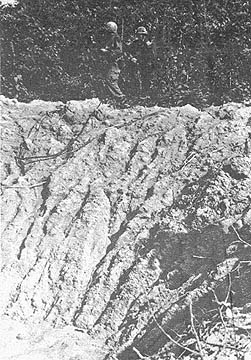 |
Dragons Pin Down 12 Hung-up NVA
CU CHI - Freshly washed laundry hanging over bamboo poles gave away
the positions of combined NVA-VC forces to the Golden Dragons recently - and it
was the enemy that hung out to dry.
Charlie Company Dragons were lifted by helicopter into the Ho Bo
Woods and began to sweep through after waiting out an air strike. Bomb
craters exposed ripped-open enemy bunkers.
Later, Private First Class Philip Parton of El Cajon, Calif., said,
"They were luxurious inside. There was room to stand up with kitchen
stove and bamboo beds."
Several bunkers were found, most of which had been destroyed by the
air strike. The infantrymen discovered ten bodies, and found two enemy
trapped in a bunker.
In the same area later on in the day, a well-camouflaged bunker was
found by Private First Class Morey Cook of the Canal Zone, Panama. The
hideaway protected a well-stocked weapons cache.
The bunker also contained three pounds of opium and an ample supply
of marijuana.
Deuces Probe Foe's Tunnels
By SP4 HENRY G. ZUKOWSKI
TAY NINH - Men of the 2d Battalion, 22d Infantry are scouring the
Boi Loi Woods, probing enemy tunnels for weapons, ammunition and supply caches.
With clearing operations by rome plow units making their searches
less like looking for needles in haystacks, the Triple Deuce soldiers have
launched an intensive effort to dispossess the enemy.
The Tropic Lightning soldiers prowl the woods probing with bamboo
sticks to find soft spots or possible hidden entrances.
"It takes longer to search an area this way, but we know we've
done a job when we're finished," said Specialist 4 Ronald Dennis of Elyria,
Ohio, a Charlie Company soldier.
Private First Class Alfred Hudson of Bell Gardens, Calif., added,
"It's easier to just probe the bunkers a little than dig all the trash out
only to find nothing, but you can't always do things the easy way."
After discovering a tunnel entrance hidden by thick grass on a
recent probe, another Triple Deuce trooper, Private First Class Ed Rivera of The
Bronx, N.Y., said, "I probably would have found that hole with my next step,
but then I'd also have wound up on the bottom of it."
Wolfhounds Can Handle Enemy
PB HANDLE - This patrol base designed to cut off enemy infiltration
into the southern half of the First Wolfhounds' area of operation has been
built near the horseshoe in the Vam Co Dong River.
Handle, manned by Alfa Company Wolfhounds and a company of 49th
ARVN Regiment troops, gets supporting fire from four howitzers of Charlie
Battery, 2d Battalion, 77th Artillery.
The M102 howitzers are mounted on paddy platforms that allow
placement of the guns inside the perimeter of the marshy outpost.
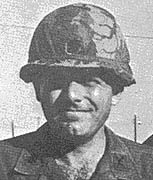 |
LIEUTENANT Colonel Forrest F. Rittgers Jr. of Marlius, N.Y., has assumed command of the 4th Battalion, 9th Infantry Manchus. The much-decorated Rittgers, a 1953 history graduate of the University of South Carolina, formerly commanded the 2d Battalion, 27th Infantry. |
Page 4-5 TROPIC LIGHTNING NEWS November 17, 1969
"We Fly for the Troops"
The 25th Aviation Battalion:
Best Flying Unit in the Army
By SP4 GARY SCIORTINO
CU CHI - "The magnificent achievements of this battalion in a
division that has engaged in some of the toughest and dirtiest fighting in
Vietnam's Hau Nghia Province are simply legendary."
That is what General Bruce Palmer Jr., Army Vice Chief of Staff,
said of the 25th Aviation Battalion as it was named the Army's outstanding
aviation unit for 1968-69 by the Army Aviation Association of America (AAAA) at
ceremonies in Washington, D.C., recently.
Lieutenant Colonel Kenneth J. Burton, the battalion's former
commander during the period for which the award was presented, and Command
Sergeant Major William H. Bennett, the present battalion sergeant major, were on
hand at the ceremonies to accept the trophy on behalf of the battalion.
"THE MOST significant factor bearing on the performance of the
battalion was a 70 per cent increase in hours flown in support of division
combat operations with a remarkable 28 per cent reduction in the unit accident
rate," stated General Palmer.
During the period for which the award was presented, Mar. 31, 1968,
through Mar. 31, 1969, the battalion's Alfa and Bravo Companies logged more
than 4000 flying hours per month. The battalion's current commander is
Lieutenant Colonel Robert R. Gosney.
The 25th Aviation Battalion flies any mission necessary for support
of ground troops. The battalion flies all standard missions including
couriers, command-and-control ships, gunships, light observation helicopters,
smoky ships and troop movements.
Its activities have made Tropic Lightning's Aviation Battalion
more than live up to its motto: "We fly for the troops."
The 25th Aviation Battalion also pioneered two other projects that
were later adopted by other aviation units throughout Vietnam.
The first was the flare rack. The design incorporated an
emergency release device which jettisoned all flares in an aircraft into a
barrel in case one malfunctions. This holds the possibilities of the
aircraft catching fire or the pilot becoming blinded to a minimum.
The other development, the light observation helicopter radio
console, offers battalion commanders of ground units a vital link to success -
free use of communications. Battalion commanders using light observation
helicopters for command-and-control ships previously had to share the craft's
one FM radio with the pilot.
THE BATTALION designed a compact console which held three FM
radios. This console allows both the pilot and the battalion commander to
operate simultaneously with separate radios and on separate channels.
"This is a unit award and a team award," declared Burton.
"I was part of the team, but basically the team consisted of the men that did
the work - the mechanics, cooks, bakers, pathfinders - everyone of them is the
unsung hero that makes our unit get results."
Tropic Lightning Commander Major General Harris W. Hollis added:
"This award to a division aviation unit, amidst all the glamorous aviation
units in the Army, indicates that this unit has truly extended itself."
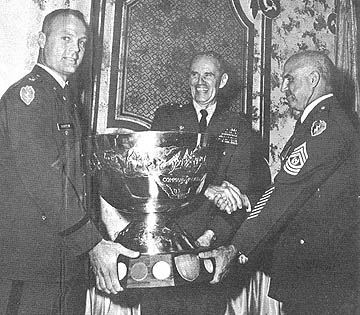 |
ARMY'S FINEST - General Bruce Palmer Jr., Army Vice Chief of Staff, (rear) presents a trophy commending the 25th Aviation Battalion as the outstanding aviation unit in the Army during 1968 to Lieutenant Colonel Kenneth Burton (left), former battalion commander, and Command Sergeant Major William H. Bennett (right), the current battalion sergeant major, during recent ceremonies in Washington, D.C. |
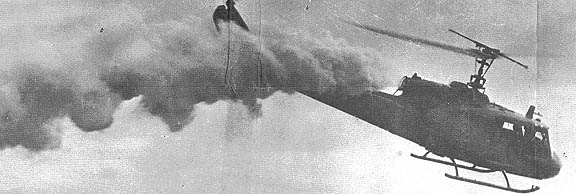 |
| A battalion smoky ship lays down a thick screen of protection for infantrymen at a landing zone. |
| A UH-1 "slick" carries a swing load to field troops. | 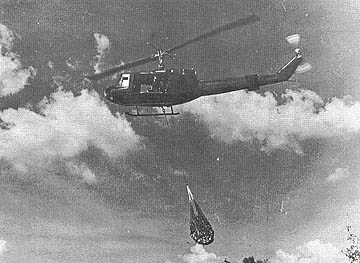 |
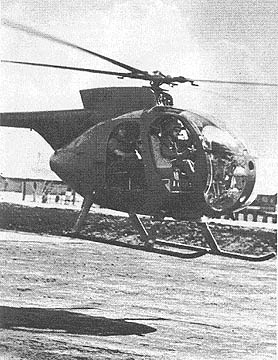 |
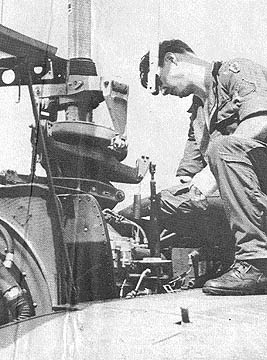 |
| Preparing for an all-night nighthawk operation. | 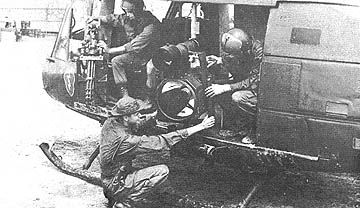 |
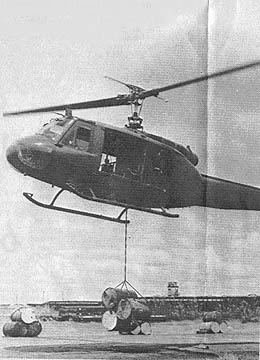 |
|
| Checking data at battalion TOC | 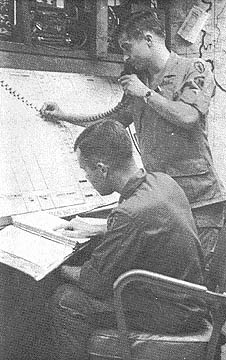 |
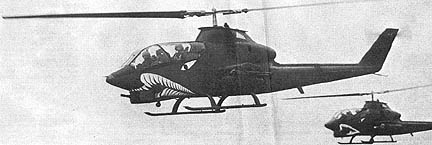 |
| Cobra gunships - Sleek and effecient weapons in the Tropic Lightning Aviation arsenal. |
Page 6 TROPIC LIGHTNING NEWS November 17, 1969
Ask Sgt. Certain
DEAR SARGE: I'm getting near the end of my tour, and would like to know how
I'll be able to tell when I'm short.
Napoleon Complex
DEAR NAP: Good old Sergeant Certain, of course, is not now, has never been and
never will be short. Like Nui Ba Den, the Vam Co Dong River, and the 25th
Replacement Detachment, he'll be here forever. However, friends of mine
have told me you can tell you're short when: nobody asks you any more
how many days you have left the way they did when you were still around 320;
you realize that it's no use writing any letters because you'll get home
before they do; you find yourself just walking right through those canals
without even bothering to look for a dry way across; you begin to worry
about things like choppers falling on you, jeeps running you over, being hit by
a meteorite and what effect all that salt peter has had on you; you check
your field gear and find you have 11 ponchos, four canteens and seven field
packs but no poncho liner or jungle hat; you find yourself smiling
idiotically for no reason; you have ham and lima beans for the 192d time;
you look at your short-timer calendar and see what a stupid idea it was;
you begin to wonder if they'll really let you go home or just send you to
Danang; you ask yourself if you'll be able to adjust to being home
again, think for a while and start smiling idiotically again.
DEAR SERGEANT: I am a company commander who's having a problem with his
first sergeant. My first sergeant is friendly, happy, never yells at the
men, never puts anyone on detail, doesn't have ulcers, and always addresses
the men as "Specialist" or "Private First Class." What is wrong
with him?
Perplexed
DEAR PERPLEXED: We know what would have happened to him back in the good old
days. But maybe the strain of being mean all the time has finally gotten
to him. It's not easy. Try reminding him that the ARs say "all
first sergeants WILL BE mean all the time, THIS MEANS YOU, and no exceptions."
DEAR SERGEANT CERTAIN: My husband, Sgt. Jerry Trumble, is with the 725th
Maintenance Battalion in Cu Chi. November 18th is our anniversary. I
was wondering if it would be possible to wish him a happy anniversary through
your column, and to tell him that he has given me the happiest days of my life.
And also, I hope and pray we'll share many more years and many more anniversaries
together.
Mary Ann Trumble
DEAR MRS. TRUMBLE: We advice-to-the-warlorn columnists are far too busy to
worry about happiness and warmth and love and things like that. Anyway,
there's nothing about them in the ARs. So it looks like I can't help
you. Sorry, Mrs. Trumble.
| NO MORE DETOUR - 65th Engineer "River Rats" hang on to guidelines, tugging and pulling against fierce updraft caused by the flying crane that brought them part of a dry span bridge, one of four the Whiskey Fifth installed along a quarter-mile section of an important convoy route. (Photo by Sp4 Garth Fike) | 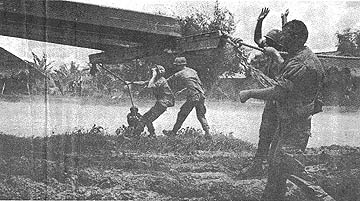 |
Neither Rain nor Heat nor Mud Stops
65th Engineers' Bridge Specialists
By SGT THOMAS JORGENSON
CU CHI - Whiskey Fifth's "River Rats" recently won another
round in the seasonal struggle against rain and mud.
On Route TL-19 just north of Fire Support Base Wood III, Echo
Company, 65th Engineer Battalion's bridge specialists, anchored four sections
of dry span over an almost impassable section of the important convoy route.
The heliborne bridges, partially pre-constructed in Echo Company's
bridge park, were airlifted to the site by Chinooks from the 20th Transportation
"Muleskinners" and CH-54 flying cranes from Long Binh.
In less than five hours, hard steel dry span bridges replaced
Under the leadership of Captain Richard W. Hoover of Canton, Ohio,
bridgemen of the second platoon guided the dry spans into position as they were
lowered by the work-horse helicopters.
Once the spans were lowered into place, River Rats stabilized the
dry span pillars and pinned in center sections of crossbeams.
Ranging from 28 feet to 45 feet in length, the four bridges assured
safe, speedy passage for the next day's convoy.
From Wolfhounds to Orphans Of Osaka: Gifts from the
Heart
F S B CHAMBERLAIN - "With the suffering and pain that war causes,
it brings a feeling of security and happiness to know that we have had a part in
alleviating the pain and suffering of children."
The words were spoken by a Charlie Company infantryman, 1st
Battalion, 27th Infantry as he stepped away from the pay line here recently.
Along the line he had donated $2 which were earmarked for The Holy Family
Orphanage in Osaka, Japan, which his battalion supports.
"Every month we send money to the home, he said, "and every
month we get a gift in return in the form of a letter - a letter of thanks.
"I think a special thanks comes from the heart of every man in my
company to the children. They give us a purpose and an even stronger
desire for peace and happiness."
Oh Grief, What Would The Head Beagle Say?
By PFC A.C. ECHTHONOKKER
CU CHI - GIs have a penchant for nicknames and part of the fun at
this Tropic Lightniing base camp is naming the host of dogs GIs have adopted.
"Brownies" and "Blackies" are here as they are everywhere
else, sleeping at their masters' feet. But the majority of pups have
more original names that frequently reflect their masters' stocks in trade.
The 3d Brigade aviation section is the home of a growing kennel of
assorted canines. The matriarch of the litter is called "Snoopy."
Her pups include "Rotor" and "Collective," (key parts of any helicopter)
and "Chicken Plate" after the armor vests the aviators wear while in flight.
"Snoopy's" pups bear a strong resemblance to "Bandit,"
who is "Abraham" to the headquarters company dog tribe. He and an
assistant, "Scouter," keep the area clear of dogs from neighboring units and
supervise the work of hootchmaids.
The dogs are well fed, with scraps from the plates of the several
hundred GIs who eat at the headquarters mess halls. What's more, the GIs
vie for the privilege of providing the dogs overnight shelter.
They are careful about the pups' health, making sure their pets
get regular checkups and shots at the vet.
The dogs are good companions, and a lot of GIs rely on them as
watchdogs against strangers.
Some animals have been decorated. Scouter, for instance has
been awarded the Purple Heart for shrapnel wounds suffered during a rocket
attack. He is also an honorary scout dog.
That honor was granted by a former brigade commander who became
familiar with the black and brown pup when Scouter upstaged the colonel during
an awards ceremony.
Recently a GI looked into shipping his special pet back to the
world with him, but the price was too high - about $200.
The pup, named Ringworm, remains at Cu Chi, where he is spending
his dog days picking and choosing among the favors GIs are eager to shower upon
him. It all goes to show that if a dog is good enough, his life isn't
always as bad as it's made out to be.
Page 7 TROPIC LIGHTNING NEWS November 17, 1969
'Hounds Join Allies for
Big MEDCAP in Border Village
PHUOC LUU - A medical civic action project that combined the
resources of Vietnamese, U.S. and Filipino forces and a volunteer American
doctor was conducted recently at this small village only three kilometers from the Cambodian
border.
"This large MEDCAP was necessary so we could effectively treat
all the people in the area," said Captain Jerry Parks of Sioux City, Iowa, the
civil affairs officer for the 2d Battalion, 27th Infantry Wolfhounds. His
office coordinated the program.
By mid-morning the Wolfhound Civil Action and MEDCAP team left Fire
Support Base Jackson to meet the waiting allied MEDPSYOP convoy at Go Dau Ha.
That force consisted of four hoi chanh-armed propaganda teams from Tay Ninh and
Go Dau Ha and the 30th and 50th ARVN PSYOP teams from Duc Hoa and Tay Ninh.
A U.S. MOBILE PSYOP team from the 6th PSYOP Battalion, an airmobile
Filipino MEDCAP team from Tay Ninh, a 25th Medical Battalion DENTCAP team and a
25th Infantry Division Support Command MEDCAP team were also ready to go.
"The hoi chanh propaganda team is one of the most effective
instruments that we have in convincing the people to talk relatives who are
suspected VC into rallying to the government of Vietnam," Parks said. "Generally, the Viet Cong are reluctant to believe that they will be well
treated, but once the Hoi Chanh teams talk to the families, they will readily
accept the promises of the Chieu Hoi program."
A CIVILIAN American doctor, William F. Mitchell of Columbus, Ohio,
accompanied the Tay Ninh MEDCAP team. He is a volunteer, sponsored by
Volunteer Physicians for Vietnam and the American Medical Association,
dedicating two months to support the pacification program here.
"I believe that my work here in Vietnam is very enlightening and
a most rewarding experience. Doing what little I can for these people is very
satisfying, though I could do much more if they could get to the hospital at Tay
Ninh," said Mitchell.
Senior advisor to Hieu Thien District, Major Ennis L. McClanahan,
described the operation as well-coordinated and highly successful. "It
was the best operation I have witnessed in the area for a long time," he said.
|
Story and Photos |
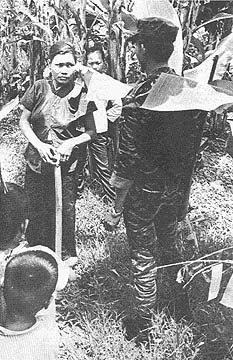 |
AN ARMED PROPAGANDA TEAM member discusses the chieu hoi program with a relative of a suspected Viet Cong. The team, once VC themselves, are invaluable to the program since the people can identify with the team members and the people readily accept the promises of the program. |
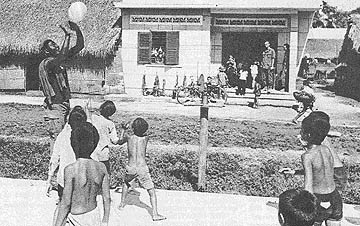 |
PLAYGROUND PACIFICATION - A Wolfhound trooper joins Phuoc Luu village children in a rough-and-tumble game of sock the balloon. The children who came to see the doctor found that all medicine is not so bad. Fun and laughter is a quick cure for some childhood ills. |
| VOLUNTEER PHYSICIAN Dr. William F. Mitchell of Columbus, Ohio, examines an aging patient during a giant medical civic action program at Phuoc Luu village near the Cambodian border. Mitchell, part of a Tay Ninh MEDCAP team, joined with men of the 2d Battalion, 27th Infantry and other allied forces during the operation. | 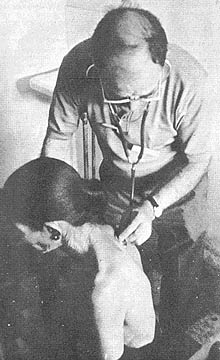 |
Page 8 TROPIC LIGHTNING NEWS November 17, 1969
Have a Water, Men; It's on Whiskey Fifth
CU CHI - Army engineers in Vietnam are known for their construction
of roads, bridges and fire support bases.
The engineers also have a breed of demolition specialists, who eat,
sleep and fight with the infantry unit they support.
BUT PERHAPS the least recognized job, yet one of the most vital
roles filled by the engineers, is providing fresh potable water.
Infantry and artillery units located at Tropic Lightning's Fire
Support Base Rawlins II, 10 miles east of Tay Ninh, have a free-flowing water
point constructed and maintained by the 65th Engineer Battalion.
Specialist 4 Albert G. Woods of Houston and Private First Class
Ronald P. McGuffy of Tuscaloosa, Ala. operate the Rawlins water point, which
provides eight hours of continuous operation each day, producing more than 4000
gallons of safe drinking and cooking water.
Woods explained the operation of his water purification unit this
way:
"WATER GOES through five basic steps. It is pumped from the
well. Then it's screened to remove most of the small particles before
chlorine is added in large enough quantities to kill harmful bacteria.
Then the water flows into a large tank where chemicals are added that combine
with the particles left in the water. This causes the particles to become
larger and heavier. Due to their larger size, they become trapped in the
filters, which represent the final step. The water is pumped out as fresh,
clean water ready for drinking."
"The most important thing," Woods says, "is to make
continuous tests to insure everything is working properly."
Regulars' Medic Branches Out as Limb Specialist
NUI BA DEN - In a crowded night position here it is difficult to
find enough space to sleep, let alone treat the sick.
But Specialist 4 James Standback of Battle Creek, Mich., solved
both problems while Charlie Company, 3d Battalion, 22d Infantry Regulars made
their way down the mountain during Operation Cliffdweller.
The practical medic set up shop in a large cypress-type tree where
he ate, slept and held sick call on the final day of the operation.
Why the tree in the first place? "After scraping my rear
all day sliding down rocks, I wasn't about to sleep on one," Standback said.
Warriors' Frogmen Find NVA Treasure
CU CHI - Amphibious Warriors of the 2d Battalion, 12th Infantry
discovered an underwater enemy warehouse during an operation recently southwest
of Fire Support Base Pershing.
Obviously the enemy made a mistake when he thought the GIs would
shy away from a few feet of water. In fact, a cool swim after walking
several thousand meters in the hot Vietnam sun is more than welcome to the men
of Charlie Company.
FIRST LIEUTENANT Billy Duncan of Atlanta was first to take the
refreshing plunge. Several men followed him and together they began poking
in the brush along the edge of the stream.
It wasn't long before the water-logged GIs' efforts were
rewarded.
Duncan described the scene: "We were searching on the east
side of the stream when we spotted an odd shape in one of the bushes. We
checked it out and found an M-16 and an AK-47 hidden there."
FURTHER PROBING of the area turned up an ammunition can containing
a bandoleer of M-16 ammo.
A continued search up the stream led to the capture of an NVA
poncho, two pairs of sandals, two gas masks, and an NVA shirt.
The only unfriendly contact made during the operation was with a
squadron of leeches. Armed only with their secret weapon, a large can of
insect repellent, the men of C Company overcame the enemy's superior numbers.
Enemy Tactics Are Outdated, Report Says
BY SSG JACK R. ANDERSON
CU CHI - The North Vietnamese and Viet Cong are still fighting
the French, in theory, and are losing on the battlefield because of it,
according to a captured NVA platoon leader.
The platoon leader, captured during an attack on the 2d Battalion,
27th Infantry's Patrol Base Kotrc, said tactics used by the NVA are a
carry-over from the war against the French and that Communist military leaders
haven't yet grasped the concept of airmobility.
"HE TOLD US about the ways enemy units set up blocking forces
expressly for the purpose of ambushing reaction forces that are supposedly
rushed by truck to the scene of an incident," a Tropic Lightning 3d Brigade
intelligence officer said.
New concepts in troop movement, such as airmobility, helicopter
gunships and electronic sensing devices have put a crimp in NVA battle plans,
but the enemy doesn't seem to be learning any lessons from these tactics, he
said.
SAPPER ATTACKS too are losing their momentum.
"Sappers who rally give us much valuable information concerning
infiltration tactics. Naturally, we've been able to beef up our defenses
against these attacks," the officer said.
But these reports aren't lulling 3d Brigade troops into a false
sense of security. "Even though the enemy may be fighting with outmoded
tactics, we're continually improving our operations to counter each move he
makes on the battlefield," he said.
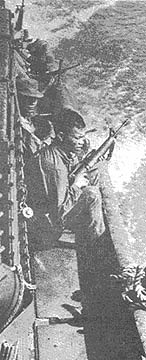 Navy Teaches 'Hounds New Trick
Navy Teaches 'Hounds New Trick
By SP4 BRAD YAEGER
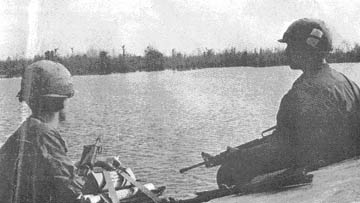 TRA CU - Thanks to the Navy the age old tactic of ambush has taken
a new twist.
TRA CU - Thanks to the Navy the age old tactic of ambush has taken
a new twist.
The floating ambush has arrived and infantrymen of Bravo Company,
1st Battalion, 27th Infantry Wolfhounds, working with the Navy and its patrol
boats here, are rapidly becoming masters of the riverfront along the Vam Co
Dong.
"ORDINARILY AN ambush has anywhere from a squad to a company
lying in wait for an unsuspecting enemy. The ambush is limited to one
location because movement at night is risky," said Specialist 4 Louis Wildman
of Indianapolis, a Bravo Company squad leader.
"Getting into position is risky because the men have to move at
dusk so they can see where they're going," he said.
The floating ambush has overcome these disadvantages. A small
group of men, no more than 15, ride two Navy patrol boats to a likely ambush
spot. The boats slip into position after dark. Infantrymen have the option of staying on board or setting
up on shore near the boats.
"THE FLOATING ambush is quite an improvement because it can cover
more area with fewer men," Specialist 4 Tommy Smith of Aublin, Ga., said.
"The boats have two .50 caliber machineguns and an automatic
grenade launcher," he said.
"The men appreciate the tactic because it takes some of the load
off them," First Lieutenant Ed Cardon of Philadelphia, said. "They're fresh
when they get into position and they have more confidence because of the extra
weapons."
"Since we've been using the floating ambush, sampan traffic on
the river at night has been virtually eliminated," Cardon said..
DEEP IN THOUGHT - (Above, left) A Vietnamese soldier contemplates the
rushing water from the deck of a U.S. Navy vessel. The Regional Forces
troopers were on a Riverine operation in the 3d Brigade operations area.
(Photo by Sp4 Bob Stephens)
KEEP A SHARP LOOKOUT - (Above, right) Members of the 1st Platoon, Bravo Company, 1st Wolfhounds,
watch the shore for signs of enemy activity as their Navy Tango boat nears the
banks of the Oriental River. The platoon was conducting a cruising RIF
through an area of recent enemy movement. (Photo by Sp4 Brad
Yaeger)
Thanks to
Ron Leonard, 25th Aviation Bn., for locating and mailing this issue,
Kirk Ramsey, 2nd Bn., 14th Inf. for creating this page.
This page last modified 8-12-2004
©2004 25th Infantry Division Association. All rights reserved.